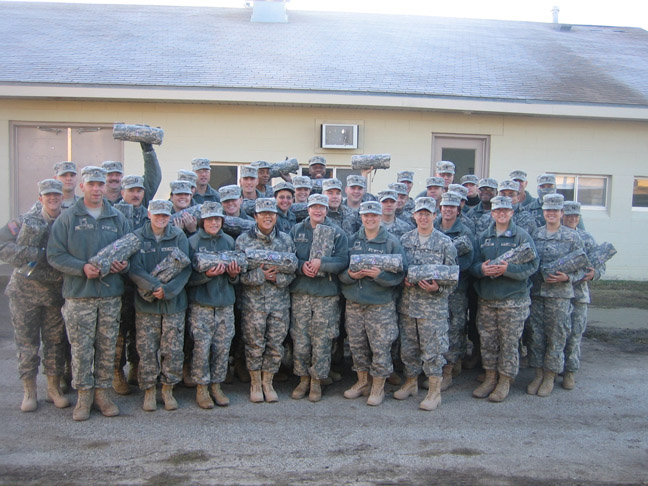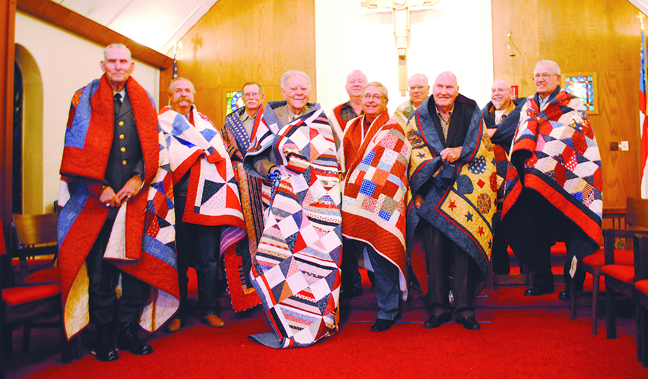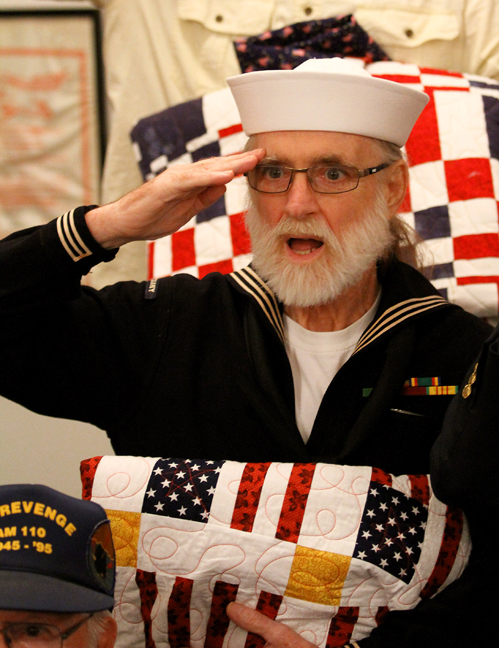BACK TO STORIES
Quilts, Comfort, and the Military
United States

Before her death in the Fort Hood massacre, SSG Amy Krueger had requested quilts for her entire unit. The Camo Quilt Project completed 46 quilts and a Plymouth, WI company had them delivered to Fort Hood before the unit deployed. Here the 467th Medical Detachment, headed by Major Laura Suttinger, is shown holding what they call “Amy’s Quilts.”
Photo reproduced with permission of Linda Wieck, The Camo Quilt Project.

Military veterans in Liberal, Kansas, were honored with Quilts of Valor at a ceremony at the local St. Andrew Episcopal Church in November 2013. As local QOV volunteer coordinator Peggy Luck said at the event before she called each to stand and accept his quilt, ““These quilts are a tangible reminder for these men that have served our country that have made sacrifices, and a tangible thank you to them….A hug is the final contact that we have with your quilt, and so the hug comes from of the Needles and Friends Quilt Guild members and from the Quilts of Valor family.”
Photo by Giseelle Arredondo/Leader & Times.

Former Seaman Tom Seymour, in his original uniform from his 1962-1965 in the Navy, gives a salute along with 35 fellow recipients of Quilts of Valor quilts in a ceremony on May 17, 2015 in Davenport, Iowa.
Photo © John Schultz/Quad City Times via Zuma Wire.
Quiltmaker Linda Wieck of Wisconsin started the Camo Quilt Project when her son-in-law, a member of the Wisconsin Army National Guard was getting ready to be deployed to Iraq and asked her to make a quilt out of the same camouflage fabric as his uniform and in a size that he could easily attach to his backpack. Fellow soldiers saw the finished quilt and also wanted one and Wieck made more. Soon requests were pouring in and a number of organizations joined Wieck in filling the requests. As of 2016, over 16,000 “camo quilts” made in colors associated with various branches of military service have been sent to soldiers, marines, and airmen.
Before her death in the Fort Hood massacre, SSG Amy Krueger had requested quilts for her entire unit. The Camo Quilt Project completed 46 quilts and a Plymouth, WI company had them delivered to Fort Hood before the unit deployed. Here the 467th Medical Detachment, headed by Major Laura Suttinger, is shown holding what they call “Amy’s Quilts.” Photo reproduced with permission of Linda Wieck, The Camo Quilt Project.
One of the largest and perhaps best known of the honoring and comforting quilt and military projects in recent history is the Quilts of Valor Project with a mission “to cover service members and veterans touched by war with comforting and healing Quilts of Valor.” As of March 2016, this effort facilitated the making and distribution of over 133, 700 quilts. The Quilts of Valor Project was started in 2003 when founder Catherine Roberts, of Seaford, Delaware, whose son Nat was deployed in Iraq, had a dream. According to Roberts:
The dream was as vivid as real life. I saw a young man sitting on the side of his bed in the middle of the night, hunched over. The permeating feeling was one of utter despair. I could see his war demons clustered around, dragging him down into an emotional gutter. Then, as if viewing a movie, I saw him in the next scene wrapped in a quilt. His whole demeanor changed from one of despair to one of hope and wellbeing. The quilt had made this dramatic change. The message of my dream was: Quilts = Healing. The model appeared simple: have a volunteer team who would donate their time and materials to make a quilt. One person would piece the top and the other would quilt it. I saw the name for this special quilt. It was a Quilt of Valor, a QOV.
Most charity and service quilt projects encouraged the use of quilt patterns that could be easily done and often did not require quilting but rather tying the three layers together. Roberts, however, had strict ideas about the visual and construction quality of QOV quilts.
I knew a Quilt of Valor had to be a quality-made quilt, not a “charity quilt.” Quilts of Valor would be the civilian equivalent of a Purple Heart award. A Quilt of Valor had to be quilted, not tied, which meant hand or machine quilting. Quilts of Valor would be “awarded,” not just passed out like magazines or videos. A Quilt of Valor would say unequivocally, “Thank you for your service, sacrifice, and valor” in serving our nation in combat.
Thus the Quilts of Valor website provides clear guidelines for size, colors, fabrics, type of batting, binding technique, design, craftsmanship and even labeling. Although the quilts do not have to be in red, white, and blue, many quilts are and nearly all are patriotic in theme. Sample patterns or designs suitable for QOV are illustrated on the website and YouTube tutorials are readily available on the Internet. Even given the restrictions of design, the variations in the quilts are remarkable and a Google search for QOV quilts reveals an array of unique quilts that incorporate eagles, medals, the American flag, and many different fabrics of solid and printed red, white, and blues. The QOV Project has a system of matching requests for quilts with honorees with those who make them and encourages the presentation of QOV quilts at events held in veteran’s centers, military hospitals, and such local public community venues such as libraries, churches, museums, and government buildings.
As veterans, often attired in their uniforms, are given their quilt, a presiding officiant reads the name of the honoree, tells about the honoree’s military service, gives information about the QOV Project, and often reads any notes, cards, journals that document the making of the quilt. Peggy Luck, conveyed the meaning of the quilts to the veterans at a QOV presentation she presided over: “One of our machine quilters has a counter on her machine, and it counts how many stitches that machine is making to put the three layers together or quilt to quilt and the counter on just one of these quilts was over 50,000,” Luck said. “And that’s just the stitches that are holding it together, not the ones that sew together each piece. “So that kind of tells you that all these stitches are the ones that you can see, the 50,000, but you know the other ones are there because you will feel the warmth of the quilt through these stitches,” she added. The middle of the quilt represents the hope that the quilt will bring comfort and warmth, maybe peace, and maybe some healing, Luck said. “The back of the quilt is a big piece of fabric and it contains everything. It holds the whole thing together and that is the strength of the quilt,” she continued. “It reminds us of the strength of each one of you soldiers. It also reminds us of the strength of the families. Families make quite a sacrifice for soldiers, and it also reminds us of the strength and support of the community and of our nation.”
At one of the presentations early on in the project to a group of Vietnam War veterans, Roberts reported that, over and over again they said, “Ma’am, this is the first time in forty years anyone has ever thanked me for my service.” The reaction of the veterans who receive QOV quilts remains the same – of deep gratitude and often statements of knowing that others cared about their service. Likely because of the patriotic element of the QOV Project, because the presentation events bring public recognition to service to the country, and because the recipient responses are so heartfelt, these events are often covered by local news media and thus bring positive attention to the overall project, to the recipients, and to the quiltmakers.
Military veterans in Liberal, Kansas, were honored with Quilts of Valor at a ceremony at the local St. Andrew Episcopal Church in November 2013. As local QOV volunteer coordinator Peggy Luck said at the event before she called each to stand and accept his quilt, ““These quilts are a tangible reminder for these men that have served our country that have made sacrifices, and a tangible thank you to them….A hug is the final contact that we have with your quilt, and so the hug comes from of the Needles and Friends Quilt Guild members and from the Quilts of Valor family.” Photo by Giseelle Arredondo/Leader & Times.
Former Seaman Tom Seymour, in his original uniform from his 1962-1965 in the Navy, gives a salute along with 35 fellow recipients of Quilts of Valor quilts in a ceremony on May 17, 2015 in Davenport, Iowa. Photo © John Schultz/Quad City Times via Zuma Wire.
The parents of a young soldier identified only as Chris who was injured and photographed while in route to medical care, on a gurney, covered in a QOV quilt, wrote a letter to the Quilts of Valor Foundation saying that “we will never forget the first pic that we saw of our son wrapped in red, white and blue. Truly it is an expression of so much love, caring, and compassion for our Soldiers, Airmen, and Sailors who have given so much for Our Country. I can assure you that it gave our Chris comfort mentally to know that folks cared as well as provided him physical warmth on the cold flights. It is now one of 'his treasures' that he has requested us to safeguard until he is out of treatment and back on his own.”
Written by MacDowell, Marsha;Luz, Clare;Donaldson, Beth (2017)
MacDowell, Marsha; Luz, Clare; Donaldson, Beth. Quilts and Health. University of Indiana Press, 2017. Page 141, 143.
Quilts and Health
-
Quilts and Health Documentation Project
Michigan State University
Load More